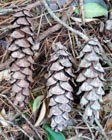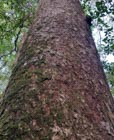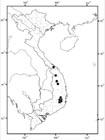Pinus dalatensis
Ferré 1960
Common names
Thông Dà; lat, Thông Nam lá (Vietnamese) (FIPI 1996).
Taxonomic notes
This is a morphologically variable species that is also rare and little-studied; recent work has elucidated two subspecies and three varieties, but knowledge remains very incomplete (Hiep et al. 2004; Businsky 1999, 2004; Averyanov et al. 2014). Farjon (2010) accepted one variety and one subspecies that had been recently described by Businský (1999), and Averyanov et al. (2014) took another species of pine described by Businský (2010), Pinus anemophila, and reduced it to the status of a variety of P. dalatensis. The infraspecific taxa so described taxa include:
- Pinus dalatensis Ferré subsp. dalatensis var. dalatensis. Type: Vietnam: Lam Dong, Da Lat, Trai Mat, H. Gaussen s.n.
- Pinus dalatensis Ferré subsp. dalatensis var. bidoupensis Businský 1999. Type: Vietnam: Lam Dong, Dong Nai, Mt. Bi Doup, W slopes of massif 6 km SE of Bi Doup, R. Businský 39160.
- Pinus dalatensis Ferré subsp. dalatensis var. anemophila (Businský) Aver. 2014. Type: Laos: Khammouan Province, east margin of Phou Ak plateau above Mu Gia Pass, ca 200 m west from plateau edge with Vietnam frontier west above road from the Cha Lo border checkpoint to the border pass; mixed forest on rugged rocky sandstone plateau, together with Fokienia hodginsii, top of sandstone rock, 995 m a.s.l., 17°40.20.8"N, 105°44.54.5"E), 2010.04.22, R. Businský 68102.
- Pinus dalatensis Ferré subsp. procera Businský 1999.Type: Vietnam: Gia Lai Prov., Ngoc Linh Mountains, Mt. Ngok Niay, R. Businský 44114.
For discussion of systematics relative to other species in subsection Strobus, see Phylogeny of East Asian white pines.
Description
Evergreen trees to 40 m tall and 250 cm dbh, typically with a single straight trunk and wide-spreading, self-pruning branches forming first conical, later domed or umbrella-shaped broad crowns, commonly as canopy emergents. Bark at first smooth, later becoming rough and scaly, breaking into small, grey-brown plates. Twigs slender, smooth, at first glabrous or pubescent, later becoming pale brown or reddish brown. Buds small, conical or ovoid, acute, not resinous; cataphylls appressed, orange-brown. Leaves in fascicles of 5, with deciduous basal sheaths, straight, spreading, (3-)5-10(-14) cm long, slender, lax, 0.6-1.2 mm wide; abaxial face green, with stomata in fine lines on the two adaxial faces; apex acute. Pollen cones in small clusters at base of new shoots, spirally arranged, ovoid to short cylindrical, yellow at maturity. Seed cones solitary or in whorls of 2-3 on stout, 1-4 cm long, scaly peduncles, persisting some time after seed dispersal, initially erect but pendulous when grown, extremely variable in size, 6-23 cm long, straight or curved, ellipsoid or cylindrical, opening to 5-9 cm wide, resinous, green ripening to brown. Seed scales flat or boat-shaped, thin woody, flexible; basal scales appressed, rarely some recurved. Apophysis large, thin or slightly thickened, more or less rhombic or with rounded distal margin, straight or slightly incurved, striated or grooved towards a terminal, 4-10 mm wide, sunken, flat or obtuse umbo. Seeds varying in size with the seed scales (especially the wings), up to 8-10 mm long with wings 30 × 10 mm. Cones begin to mature in February and March and reach maturity in October-December (FIPI 1996, Farjon 2010).
The infraspecific taxa are distinguished as follows:
- P. dalatensis subsp. dalatensis var. dalatensis: New shoots variably pubescent, seed cones 6-16 cm long.
- P. dalatensis subsp. dalatensis var. bidoupensis: New shoots glabrous, seed cones 10-16 cm long.
- P. dalatensis subsp. dalatensis var. anemophila: Seed cones 6-12 cm long.
- P. dalatensis subsp. procera: New shoots (mostly densely) pubescent, seed cones 9-23 cm long.
Distribution and Ecology
Vietnam: Thua Thien Hue (Phu Loc), Kon Tum (Ngoc Linh), Gia Lai (Kon Ka Kinh NR), Dac Lac (Chu Yang Sing and other massifs), Lam Dong, (Bi Doup mountain), Ninh Thuan (Phuoc Binh) (Luu and Thomas 2004). Laos: Khammouan and Saravan provinces (Averyanov et al. 2014). The infraspecific taxa are distributed as follows:
- P. dalatensis subsp. dalatensis var. dalatensis: Vietnam: Binh Tri Thion, Dac Lac, Lam Dong (Chu Yang Sinh Massif, Da Lat environs); Laos: Nakai Nam Theun NPA.
- P. dalatensis subsp. dalatensis var. bidoupensis: Vietnam: Lam Dong (Bi Doup Mountain).
- P. dalatensis subsp. dalatensis var. anemophila: Vietnam: Quang Binh province; Laos: Khammouan and Saravan provinces.
- P. dalatensis subsp. procera: Vietnam: Gia Lai-Cong Tum (Ngoc Linh, Ngok Niay Mountain, Kon Plong); perhaps across the border in Laos.
This species occupies yellow ferallitic soils or shallow dark gley soils, at elevations of 1400-2300 m; the mean annual temperature is 16-21°C, with annual rainfall >1800 mm. P. dalatensis grows in primary closed evergreen tropical seasonal coniferous or mixed submontane and montane forests. Usually the pines occupy rocky outcrops or steep ridges where there is competition from broad-leaved trees. On optimal sites, such as flat mountain ridges or in foothills near streams, it can become a large emergent tree. In central Vietnam, it often forms small stands of up to about 30 trees within an evergreen angiosperm forest dominated by members of the Fagaceae and Lauraceae. In the southernmost Central Highlands, it can be found with other conifers including P. krempfii (another emergent pine), P. insularis, Dacrydium elatum and Chamaecyparis hodginsii. In most cases, this pine can grow rapidly up to reach the canopy, so it is semi-shade tolerant, but seedlings are intolerant of shade, so some form of canopy disturbance has to precede regeneration, e.g. periodic fires. Regeneration has been observed primarily at forest edges and along streams (FIPI 1996, Hiep et al. 2004, Farjon 2010).
The foregoing description needs some significant changes to include var. anemophila: it grows at elevations of 800-1200 m on acidic silicate soils derived from sandstone, where it is found with an array of conifers including Keteleeria evelyniana, Pinus latteri, Calocedrus macrolepis, Chamaecyparis hodginsii, Dacrycarpus imbricatus, Dacrydium elatum, Nageia wallichiana, Podocarpus neriifolius and Podocarpus pilgeri (Averyanov et al. 2014).
Populations are few and small, and several have been in continuous decline; on the other hand, given recent discoveries and their disjunct occurrence, new populations are likely to be found. Some of these are in as yet undisturbed forests. The main threat in the past was logging, when this species was often taken during harvest of Chamaecyparis hodginsii; currently, the principal threats are habitat loss, mostly conversion to plantation forest (typically Pinus kesiya) or to other land uses such as slash-and-burn agriculture. Several populations are within recently declared national parks and nature reserves. Although the species as a whole has been assessed as Near Threatened, the status of the infraspecific taxa, although logically Near Threatened or worse, has generally not been assessed because of insufficient data (Hiep et al. 2004, Farjon 2010). However, Averyanov et al. (2014) offer this assessment of var. anemophila: "only two extant subpopulations of P. dalatensis var. anemophila are known. They occupy summits of sandstone ridges running along the Laos–Vietnamese border in central part of Truong Son Range and have a very limited area of occurrence and occupancy that are certainly less than 5000 and 500 km2 respectively. Both discovered subpopulations exhibit high fragmentation and progressive decline of their area and quality of habitats hence status "Endangered" may be applied globally and nationally for both countries following criteria B1ab(i, iii, v), B2ab(ii, iii, v)." Hiep et al. (2004) recommend conservation actions as follows: "Regular monitoring of forest fires and local logging is the primary course of action for conservation of this species. Understanding the response of this tree to forest fire is important to ensure suitable regeneration. Genetic variation in species seems to be high, so ex situ gene conservation areas should be set up for the species. However, appropriate sites should be well chosen since this pine may require specific growing conditions, including the presence of mycorrhiza."
Zone 10 (cold hardiness limit between -1°C and +4.4°C) (Bannister and Neuner 2001).
Remarkable Specimens
Averyanov et al. (2014) state that stands of var. anemophila on mountain tops of Xe Xap protected area in eastern Saravan province (Laos) near the Vietnamese border have some trees 40 m tall and 1.5 m in diameter. They also cite similar stands from the southern part of the Nakai Nam Theun protected area (Khammouan province).
Hiep et al. (2004) assert maximum ages of "several hundred years" without supporting data, and Averyanov et al. (2014) allege many trees older than 500 years, without supporting data.
Ethnobotany
Due to its rarity, it is chiefly useful as an ornamental (FIPI 1996), although some incidental harvest has occurred during logging of Chamaecyparis hodginsii (Hiep et al. 2004). Potentially, it could be a valuable timber tree. Its wood properties are similar to those of Pinus wallichiana, a native of the Himalayas, and other white pines (Farjon 2010).
Observations
The main populations in Kon Tum, Dac Lac, Lam Dong and Ninh Thuan are all within recently declared national parks and nature reserves; these would seem to be logical places to seek it (Hiep et al. 2004).
Remarks
The epithet refers to the city of Dalat, near the type locality.
Citations
Averyanov, L. V., T. H. Nguyen, K. N. Sinh, T. V. Pham, V. Lamxay, S. Bounphanmy, S. Lorphengsy, L. K. Phan, S. Lanorsavanh, and K. Chantthavongsa. 2014. Gymnosperms of Laos. Nordic Journal of Botany 32(6):765–805.
Businský, R. 1999. Study of Pinus dalatensis Ferré and of the enigmatic “Pin du Moyen Annam.” Candollea 54 (1): 125-143.
Businský, R. 2004. A revision of the Asian Pinus subsection Strobus. Willdenowia 34 (1): 39-57.
Businský, R. 2010. A new species of soft pine from the Vietnamese border of Laos. Acta Pruhonic. 96: 5–13.
Farjon, Aljos. 2010. A Handbook of the World's Conifers. Leiden, Netherlands: Brill Academic Publishers.
Ferré, Y. de. 1960. Une nouvelle espèce de pin au Viet-Nam. Pinus dalatensis. Bull. Soc. Hist. Nat. Toulouse 95:171-180.
Forest Inventory and Planning Institute [FIPI]. 1996. Vietnam forest trees. Hanoi: Agricultural Publishing House. Pp 1-23.
Hiep, N. T., P. K. Loc, N. D. T. Luu, P. I. Thomas, A. Farjon, L. V. Averyanov, and J. C. Regalado Jr. 2004. Vietnam Conifers: Conservation Status Review 2004. Fauna & Flora International, Vietnam Programme, Hanoi.
See also
The species account at Threatened Conifers of the World.
Bachman, S., Farjon, A., Gardner, M., Thomas, P., Luscombe, D., and C.Reynolds. 2007. Pinus dalatensis. In: 2008 IUCN Red List of Threatened Species. www.iucnredlist.org, accessed 2009.04.10.
Luu and Thomas 2004 provide a description, range map, conservation status, drawings and photos, and a wealth of additional information.
Nguyễn, Đ. T. L., and P. I. Thomas. 2005. Conifers of Vietnam. Nhà xuất bản Thế giới, Hà Nội, Vietnam. 121 p.






